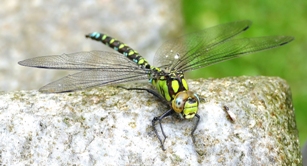Aeshna cyanea, commonly known as the Southern Hawker, is one of the largest and most widespread dragonflies in Europe. It is easily identifiable by its vibrant colors: the male has a bright green and blue body with striking spots, while the female has a more subdued brown body with green markings. Its flight is fast and agile, often seen hunting over ponds or shaded woodlands. It has the ability to fly forward and backward and hover in place, making it an efficient predator.

Scientific Classification:
- Kingdom: Animalia
- Phylum: Arthropoda
- Class: Insecta
- Order: Odonata
- Family: Aeshnidae
- Genus: Aeshna
- Species: Aeshna cyanea
Dimensions and Weight: Aeshna cyanea is one of the largest dragonflies in Europe, with a wingspan that can reach up to 90 mm and a body length ranging from 70 to 80 mm. The average weight is around 0.3-0.4 grams. These significant dimensions allow it to be a fast and powerful aerial predator.
Habitat: This dragonfly prefers ponds, lakes, and ditches with stagnant or slow-moving water surrounded by dense vegetation. However, it can also be found in gardens and forests near water bodies. It is highly adaptable and can live in shallow waters as well as in shaded areas, though it remains closely tied to water for egg-laying purposes.
Behavior and Habits: Aeshna cyanea is a voracious predator, spending most of its time hunting other flying insects, such as mosquitoes and flies. It is particularly active on warm, sunny days, but can also be seen in cooler weather, especially towards the end of summer. The mating season occurs between July and October, with females laying eggs in aquatic plants or submerged vegetation. The larvae live in water and take about two years to complete their development before emerging as adults.

Dangers, Enemies, and Threats: The larvae of Aeshna cyanea are preyed upon by fish, frogs, and water birds, while adult dragonflies can be captured by birds or bats. However, the main threat to this species is habitat loss due to pollution and the destruction of wetland areas, which reduces the availability of breeding sites. Additionally, climate change may alter the life cycles of this dragonfly, affecting its geographical distribution.
Protected or Endangered Species: Aeshna cyanea is not currently considered an endangered species, but habitat loss poses a concern in some regions. In many European countries, wetlands are protected to ensure the conservation of dragonflies and other aquatic insects. Conservation efforts focus on preserving their natural habitats to ensure that these creatures continue to thrive.
![]() Aeshna cyanea
Aeshna cyanea 



